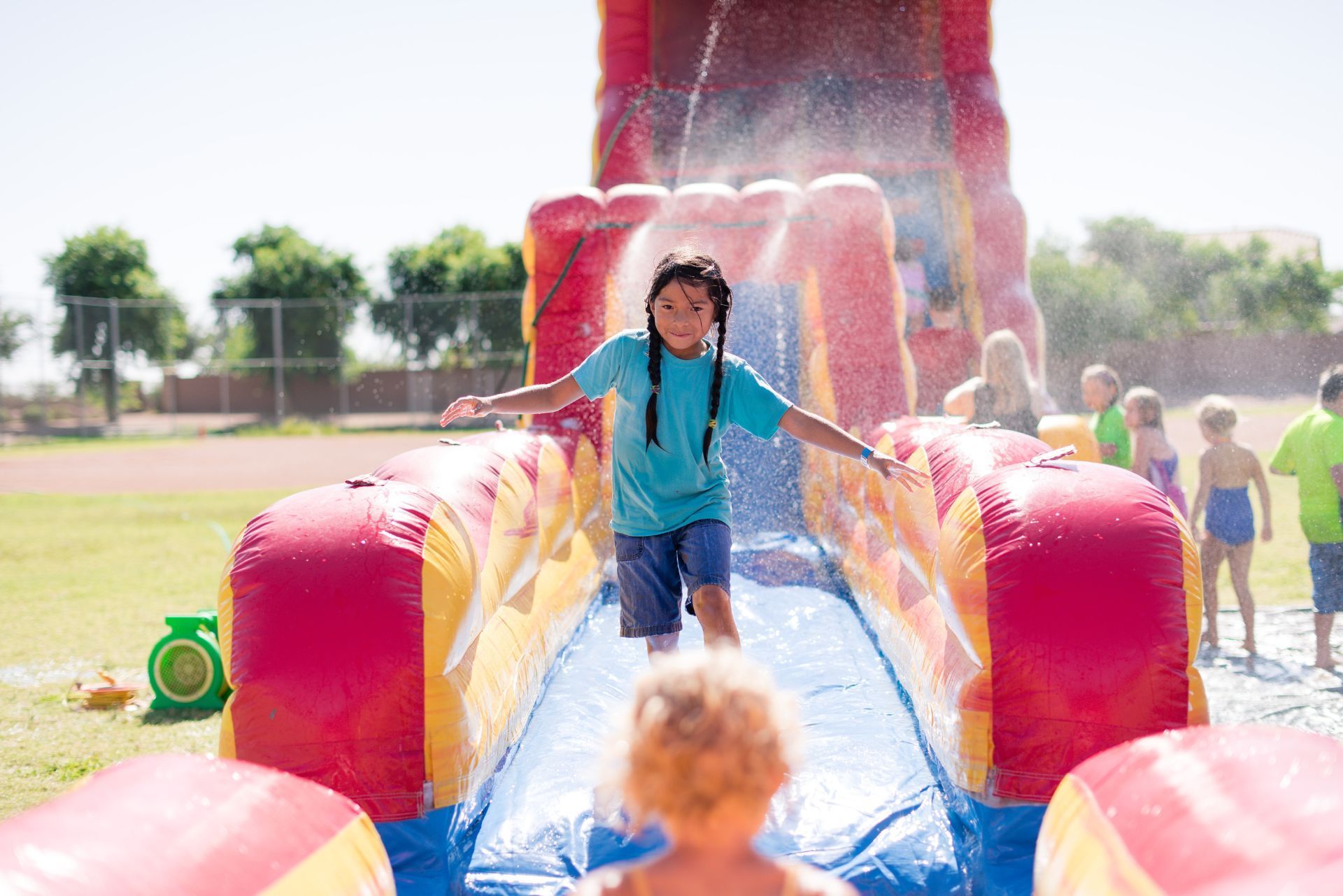Top 3 Recommended Policies

Bounce houses have become a staple of outdoor celebrations, from birthday parties to community events. They provide hours of entertainment for children and are a great way to keep the little ones active. However, with their popularity comes the responsibility of ensuring safety and managing risks. This is where bounce house insurance comes into play. Understanding the ins and outs of this type of insurance is crucial for anyone involved in the rental or operation of bounce houses.
What is Bounce House Insurance?
Bounce house insurance is a specialized type of liability insurance designed to protect businesses and individuals who rent out inflatable structures. This insurance covers a range of potential risks associated with operating bounce houses, including accidents, injuries, and property damage. It is essential for anyone in the bounce house rental business to have adequate coverage to safeguard against unforeseen events.
Types of Coverage
There are several types of coverage options available under bounce house insurance. The most common include general liability insurance, property insurance, and equipment insurance. Each type serves a different purpose and provides varying levels of protection.
General liability insurance is the cornerstone of bounce house insurance. It protects against claims of bodily injury or property damage that may occur during the rental period. For instance, if a child gets injured while using the bounce house, this insurance can cover medical expenses and legal fees.
Property insurance, on the other hand, covers damage to the bounce house itself. This can include damage from weather events, vandalism, or accidents during transport. Equipment insurance is similar but focuses on other equipment associated with the rental business, such as generators or blowers.
Why is Insurance Necessary?
The need for insurance in the bounce house business cannot be overstated. Accidents can happen, even in the safest environments. Without proper insurance, operators could face significant financial losses due to lawsuits or damage claims. Insurance not only protects the business but also provides peace of mind to customers, knowing that they are renting from a responsible provider.
Moreover, many venues and event organizers require proof of insurance before allowing bounce houses on their property. This requirement is in place to ensure that all parties are protected in the event of an accident. Having the right insurance can open doors to more rental opportunities and enhance the credibility of the business.
In addition to the standard coverage options, some insurance providers offer specialized policies that cater to unique needs within the bounce house industry. For example, some policies may include coverage for specific events, such as birthday parties or corporate gatherings, where the risk profile may differ. This tailored approach allows business owners to select coverage that aligns closely with their operational practices, ensuring they are adequately protected against the specific risks they may encounter.
Furthermore, operators should also consider the importance of training and safety measures in conjunction with their insurance policies. Implementing safety protocols, such as regular inspections of the inflatable structures and proper setup procedures, can significantly reduce the likelihood of accidents. Insurers may even offer discounts for businesses that demonstrate a commitment to safety, making it a win-win situation for both the operator and the insurance provider.

Understanding Liability Risks
Liability risks are a critical aspect of bounce house insurance. Understanding these risks can help operators take proactive measures to minimize potential claims. Common liability risks include injuries from falls, collisions, and improper use of the inflatable structures. The nature of bounce houses, which are designed for fun and excitement, can sometimes lead to a false sense of security among users, making it imperative for operators to be vigilant and proactive in risk management.
Common Injuries
Injuries in bounce houses can range from minor scrapes and bruises to more serious accidents. Falls are the most common cause of injury, often occurring when children jump from the inflatable to the ground. Collisions between jumpers can also lead to injuries, especially if the bounce house is overcrowded. In addition to these, other injuries may arise from improper landings or rough play, which can result in sprains or fractures. Operators should be aware that even seemingly minor injuries can lead to significant liability claims if not addressed properly.
To mitigate these risks, operators should enforce strict safety rules, such as age and weight limits, and supervise the bounce house during use. Additionally, providing clear instructions and safety guidelines can help prevent accidents and ensure a safer experience for all participants. Regular inspections and maintenance of the inflatable equipment are also crucial; ensuring that the bounce house is in good condition and free from hazards can significantly reduce the likelihood of injuries. Operators may also consider implementing a safety briefing before use, where children and parents are informed about safe jumping practices and the importance of following the established rules.
Legal Considerations
When operating a bounce house rental business, understanding the legal landscape is crucial. Operators should be familiar with local regulations regarding inflatable rentals, including safety standards and insurance requirements. Many states have specific laws governing the operation of bounce houses, which can vary widely. This may include requirements for operator training, equipment inspections, and even the need for permits or licenses. Staying informed about these regulations is essential for compliance and can help prevent legal issues down the line.
Furthermore, having a well-drafted rental agreement that includes liability waivers can help protect operators from legal claims. These agreements should clearly outline the responsibilities of both the operator and the renter, ensuring that all parties understand the risks involved. It is also advisable for operators to consult with legal professionals to ensure that their contracts are comprehensive and enforceable. Additionally, maintaining comprehensive insurance coverage is vital; operators should regularly review their policies to ensure they are adequately protected against potential claims, including those arising from unforeseen circumstances such as extreme weather conditions or equipment failure. By taking these legal considerations seriously, operators can create a safer environment for their customers while safeguarding their business interests.
Choosing the Right Insurance Provider
Finding the right insurance provider is essential for securing adequate coverage for a bounce house business. Not all insurance companies offer the same level of expertise or coverage options, so it's important to do thorough research.
What to Look For
When selecting an insurance provider, operators should look for companies that specialize in event and amusement insurance. These providers will have a better understanding of the unique risks associated with bounce houses and can tailor coverage to meet specific needs.
Additionally, it is beneficial to choose a provider with a strong reputation for customer service. A responsive insurance company can make the claims process smoother and provide guidance during emergencies. Reading reviews and seeking recommendations from other bounce house operators can also help in making an informed decision. Furthermore, operators should inquire about the provider's claims handling process. Understanding how quickly and efficiently claims are processed can give peace of mind, knowing that support is readily available when needed. Some providers even offer online portals for claim submissions, which can streamline the experience significantly.
Cost of Bounce House Insurance
The cost of bounce house insurance can vary widely based on several factors, including the size of the business, the number of units rented, and the coverage limits chosen. On average, operators can expect to pay anywhere from a few hundred to several thousand dollars annually for insurance.
While it may be tempting to opt for the cheapest policy available, it is crucial to ensure that the coverage is adequate. Cutting corners on insurance can lead to significant financial repercussions in the event of an accident. Operators should consider their specific needs and budget when evaluating different insurance options. Additionally, it’s wise to ask about any discounts that may be available for safety training or risk management programs. Many insurers offer incentives for businesses that demonstrate proactive measures to reduce risks, which can help lower premiums while enhancing overall
safety standards. Understanding the nuances of each policy, such as liability limits, exclusions, and endorsements, can also empower operators to make more informed decisions that align with their business goals.
Safety Measures for Bounce House Operations
In addition to having insurance, implementing safety measures is vital for reducing liability risks and ensuring a safe environment for users. Operators should prioritize safety in every aspect of their business, from setup to supervision.
Setup and Maintenance
Proper setup and maintenance of bounce houses are critical for ensuring safety. Operators should follow the manufacturer's guidelines for installation, which typically include securing the inflatable to the ground and ensuring that it is adequately inflated before use.
Regular maintenance checks are also essential. Operators should inspect bounce houses for any signs of wear and tear, such as holes or frayed seams, and address any issues immediately. Keeping equipment in good condition not only enhances safety but also prolongs the lifespan of the inflatable. Additionally, operators should clean the bounce houses regularly to prevent the buildup of dirt and germs, which can pose health risks to users. A thorough cleaning regimen can include using non-toxic disinfectants and ensuring that the inflatable is completely dry before storage to prevent mold and mildew growth.
Supervision and Rules
Supervision is another key aspect of safety. Operators should always have a responsible adult present to monitor the bounce house during use. This person can enforce safety rules, such as limiting the number of jumpers and ensuring that children follow proper bouncing techniques.
Establishing clear rules for use is also important. Operators should provide guidelines for jumpers, including age restrictions, weight limits, and instructions on safe bouncing behavior. Posting these rules prominently at the bounce house can help reinforce safety messages. Furthermore, operators may consider conducting a brief safety orientation for users before allowing them to enter the bounce house. This orientation can cover essential safety tips, such as how to enter and exit the inflatable safely, the importance of bouncing in designated areas, and the need to avoid rough play. By fostering an environment of awareness and responsibility, operators can significantly enhance the overall safety of the bounce house experience.
Insurance Claims Process
Understanding the insurance claims process is essential for bounce house operators. In the event of an incident, knowing how to navigate the claims process can help minimize stress and ensure timely resolution.
Steps to Take After an Incident
If an accident occurs, the first step is to ensure the safety of all participants. Administer first aid if necessary and call for medical assistance if injuries are severe. Once the immediate situation is under control, operators should document the incident thoroughly.
Taking photos of the scene, collecting witness statements, and recording details about the incident can be invaluable when filing a claim. Operators should also notify their insurance provider as soon as possible to initiate the claims process. Most insurance companies have specific timelines for reporting incidents, so prompt communication is crucial.
In addition to documenting the incident, operators should also review their insurance policy to understand the coverage limits and exclusions that may apply. This knowledge can empower operators to ask informed questions when communicating with their insurance provider. Furthermore, keeping a detailed log of all communications regarding the incident, including dates, times, and the names of the representatives spoken to, can be beneficial in case of any disputes or delays in processing the claim.
Working with Insurance Adjusters
After a claim is filed, an insurance adjuster will typically be assigned to investigate the incident. Operators should be prepared to provide all necessary documentation and cooperate fully with the adjuster's inquiries. This may include sharing maintenance records, rental agreements, and any other relevant information.
It is essential to remain honest and transparent throughout the process. Misrepresenting facts can lead to denial of the claim and potential legal issues. Once the investigation is complete, the insurance company will determine whether the claim is valid and what compensation, if any, will be provided.
During this phase, operators may also want to consider seeking advice from a legal professional or an insurance expert, especially if the claim involves significant damages or potential liability issues. These professionals can help interpret the insurance policy language and ensure that the operator's rights are protected. Additionally, understanding the typical timeline for claims processing can help operators manage their expectations and plan accordingly, as some claims can take longer than others due to various factors such as the complexity of the incident or the volume of claims being processed by the insurer.

Conclusion
Bounce house insurance is a vital component of operating a successful rental business. Understanding the types of coverage available, the associated risks, and the importance of safety measures can help operators protect their business and provide a safe environment for customers.
By choosing the right insurance provider, implementing effective safety protocols, and being prepared for the claims process, bounce house operators can navigate the complexities of the industry with confidence. Ultimately, prioritizing safety and responsibility not only protects the business but also enhances the enjoyment of the bounce house experience for everyone involved.
In a world where fun and safety can go hand in hand, bounce house insurance plays a crucial role in ensuring that celebrations remain joyous and worry-free.
Contact Us


